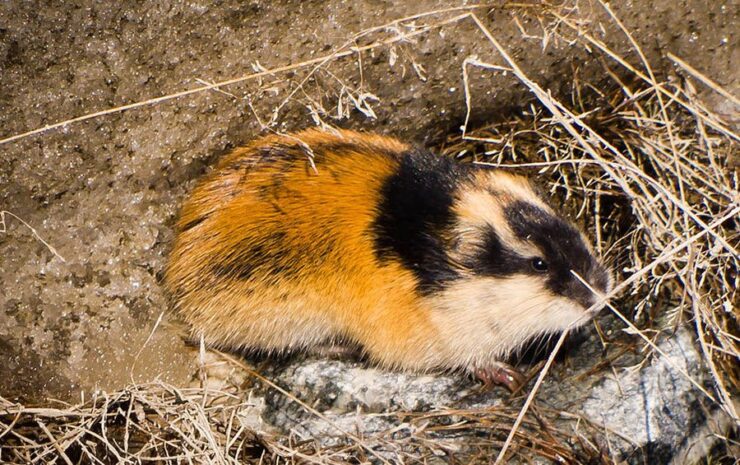Distinguishing Features – Length: 13 – 15 cm; Tail: 2 cm; stout bodies, thick fluffy fur, small ears, very short tails, and long claws.
Habitat
Tundra, grassy land of northern Scandinavia and western Russia.
Diet

Diet consists mainly of grass, little shrubs and above all, moss; also avaiable insects in summer.
Notes
The noticable marked norway lemming is active during the day and at night; times of acitvity are alternating with small breaks. In the winter, it constructs tunnels under the snow, so that it can search for food on the ground. In spring, when the snow is still there, the mating season begins, and during the summer, the no less than 8 litters with 6 young each are reared.
Lemmings are known for their explosive population, which occurs every 3-4 years. If there’s a mild spring after 1 or 2 years of low population density, lemmings usually reproduce very much in the same or in the following year. More and more animals go from the mountains to the valleys. Many lemmings are eaten by enemies and a bigger number dies, when they try to cross rivers and seas.
About Lemmings in General

“Lemming” is a name for several species of mouselike rodents related to the voles. All live in arctic or northern regions, inhabiting tundra or open meadows. They frequently nest in underground burrows, particularly in winter, although they do not hibernate. All are approximately 13 cm long.
The brown to black Norway lemming, Lemmus lemmus, of Scandinavia, is the best known, because of its spectacular periodic swarming. Two or three times per decade, this species undergoes a population explosion of such proportions that the lemmings set out in all directions in search of food. They cross bodies of water by swimming and occasionally some reach and enter the ocean, where they drown. This behavior has given rise to folklore about lemmings committing mass suicide.
Other species of the genus Lemmus are found in the northern portions of Eurasia and North America and sometimes exhibit similar swarmings. The Snow or Collard lemmings, Dicrostonyx, found in the arctic regions of Asia and North America, are pure white in winter and brown, gray, or reddish in summer; this color change is unique among rodents. They are also distinguished by the growth in winter of an extremely long two-pronged claw on the third and fourth finger of each forefoot; these claws may function in shoveling snow.
Bog lemmings, members of the genus Synaptus, are found in marshy places in North America as far south as the northern U.S. states.
The Wood lemming, Myopus schisticolor, is found in northern Eurasia.
The Steppe lemmings, members of the genus Lagarus, of southern Russia and Mongolia, are properly classified as voles; the North American species of this genus, Lagarus curtatus, is found in the western United States and is known as the Sagebrush vole.
Lemmings are classified in the phylum Chordata, subphylum Vertebrata, class Mammalia, order Rodentia, family Cricetidae.

